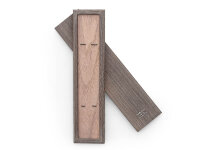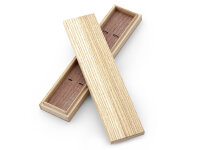
Japanese Chopsticks
Japanese Chopsticks - Savoring Meals Mindfully
For over 3000 years, people around the world have been eating with chopsticks. Today, surprisingly, there are more than one billion users worldwide, far surpassing users of traditional Western cutlery. The origins of this practice date back millennia and were primarily driven by practical reasons: chopped ingredients cook faster and absorb the flavors of sauces and spices more intensely. In ancient China, it was likely used to avoid burning fingers while eating hot food. However, this age-old tradition remains steadfast. Even in the West, more and more non-Asians are embracing the use of chopsticks, whether dining at a Chinese restaurant or an elegant Japanese establishment.
Disposable Chopsticks Only Out of Consideration for Guests
In China, Asian disposable chopsticks were introduced for hygiene reasons. However, they have fallen out of favor due to the fact that over 40 billion pairs of chopsticks are consumed each year, leading to the destruction of many trees. Elegant chopsticks made from high-quality wood, on the other hand, can be used without concern for years. They come in richly decorated designs, unfortunately sometimes bordering on kitsch, or in minimalist, pure designs. Some are also protected with urushi, while other recommended options are made from noble hardwoods. Once you've used elegant chopsticks, you won't want to put them down!
Eating with Chopsticks Is Stylish and Trains the Mind
Most people quickly become proficient with chopsticks. Over time, you'll find yourself preferring to eat many dishes from Japanese and Chinese cuisine with chopsticks rather than a knife and fork. Compared to the less aesthetically pleasing method of shoveling - mainly prevalent in China - eating with chopsticks is a very stylish affair. Choose deliberately, eat slowly and mindfully. The idea that the mind is trained during eating is no myth. After all, over 30 muscles are at work when you bring that delicious morsel to your mouth. In Japan, a set table without chopsticks is unthinkable, whether it's a dish with rice (e.g., sushi) or a noodle dish (Asian). Instead of using a knife and fork, Japanese chopsticks complete the place setting and are an important part of Japanese dining culture.
Similar to the use of cutlery in the West, there are also some important rules in Japan for the correct use of chopsticks. Japanese chopsticks should never be stuck into rice, drummed on the table with chopsticks, or pointed at other people. Chopsticks should always be placed on special chopstick rests. Exploring Japanese table culture is worthwhile for anyone who wants to dine respectfully and politely in a Japanese restaurant and in the company of Japanese people. Japanese and Chinese cuisine, especially sushi and the like, are exciting pieces of culture with many dining peculiarities. We have created an article in the Oryoki Blog that covers all the rules, table manners, and faux pas related to eating with chopsticks.
Read the blog post "Eating with Chopsticks the Right Way" »
Cultural Differences in Chopstick Use
Using chopsticks is part of everyday life in many Asian countries. In all Asian regions, there are chopsticks available in every price range. However, each country has its own peculiarities, both in use and in the material and shape of the chopsticks. It's important to note that these descriptions are not universal and there are modern design approaches in all countries that can deviate significantly from historical traditions.
Korean Chopsticks: Often, chopsticks in Korea are not made of wood or plastic but of metal. These chopsticks have a completely different grip and possibly a different weight. They are also flatter to make it easier to cut food. If you are used to Japanese chopsticks, you might find it a bit more challenging to enjoy Korean sweet potato glass noodles, for example.
Chinese Chopsticks: The main difference from Japanese chopsticks is their length. Like in Japan, chopsticks in China are often made of wood (frequently bamboo) and have a rectangular shape. However, Chinese chopsticks are on average slightly longer, which is related to the fact that the rice bowl is not brought to the mouth as often as in Japan or Thailand.
Japanese Chopsticks: These chopsticks are also frequently made from wood or bamboo and are often round. For very high-quality chopsticks, ebony, bamboo, or rosewood are often used. The most luxurious version is chopsticks made from snake wood, which are also available in our shop (Tokusen Kashikosa Snake Wood Chopsticks »). Unlike Chinese chopsticks, Japanese chopsticks are on average slightly shorter.
Oryoki Offers a Fine Selection of Handcrafted Chopsticks
The carefully selected chopsticks in our online shop are timeless craftsmanship from the Marunao and Kihachi manufactories in Japan. Both combine traditional craftsmanship with modern design, resulting in chopsticks made from precious woods whose touch alone is a pleasure. The combination of the finest woods and precise craftsmanship creates an aura of elegance. The offerings at Oryoki range from chopsticks in various colors, such as red, black, and brown, to chopsticks in different wood varieties. No matter which chopsticks best suit your personal taste, these chopsticks provide lasting enjoyment!


